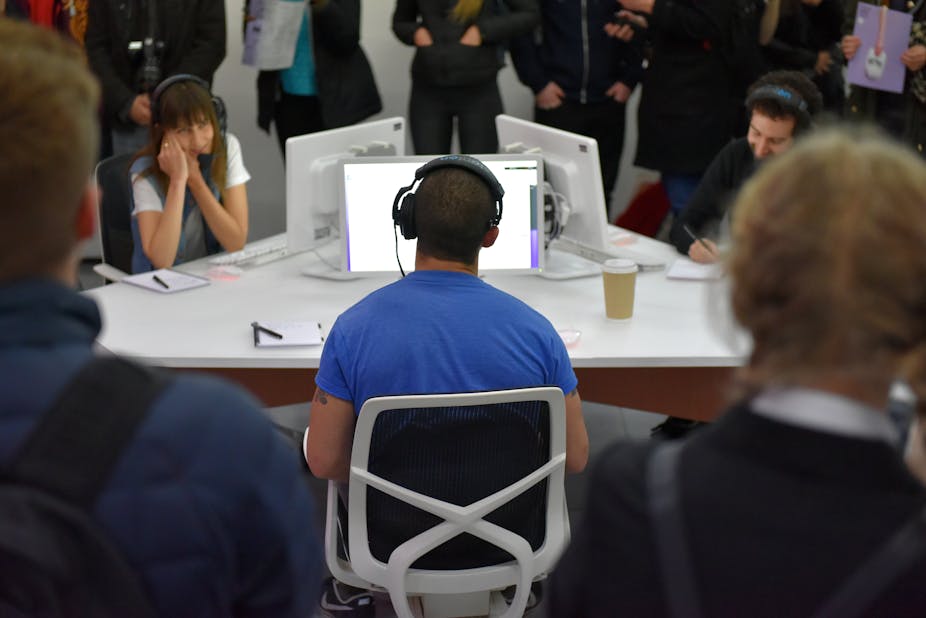The Hollywood actor Shia LaBeouf sits around a table with two members of his performance art collective. They are all plugged in, typing frantically while speaking on the phone and engaging in conversation with an endless stream of callers. All calls start with the line above.
LaBeouf insisted that he wanted to be “moved” by the exercise – and to prove his seriousness, vowed to tattoo himself with the words that touched him the most after four days of uninterrupted conversations.
This all took place at the Foundation of Art and Creative Technology (FACT) in Liverpool from December 11 to 14. I found myself as an observer and participant in another moment of heightened celebrity culture, witnessing a performance about our insatiable need for contact, capture and immersion in the world of the big and famous. The difference here, though, is that this need was being met by the celebrity himself, directly, and in real-time.
LaBeouf’s way to address his need for real “connection” with people has been to become a performance artist. After his decision to walk the red carpet for the premiere of Lars Von Trier’s Nymphomaniac with his face covered by a paper bag (“I am not famous anymore”), the actor has explored live expression in an art gallery (#IAMSORRY) and in a cinema hall (#ALLMYMOVIES) while being streamed online. Some of these works have attracted accusations of plagiarism of well-established live art performances such as Marina Abramović’s “The Artist is Present”. To this, LaBeouf’s collective responds bluntly: they are not celebrating the presence of the artist but, rather, its absence.

Regardless of our views on their originality, the collective are achieving something other artists in this field have not: a large and global online following. As a Disney prodigy and Hollywood blockbuster star, LaBeouf’s forays into the world of performance art are reaching out to an audience far beyond the avant garde arts world – and making the conversation around live art interventions considerably bigger than ever before. The value of this? Well, art needs to reach more people and it can do just that through such global figures. The challenge, however, is exactly how you critique a system of which you are a part.
At the clinical-looking exhibition space staging LaBeouf’s call centre, there was a small window that looked out into FACT’s reception area. The window was filled by a moving wall of handheld devices and the odd written message to the celebrity. These messages were not part of the event’s rationale, so were politely taken away at regular intervals by the security guards.
Inside, in advance of the event’s official opening and before the broader public were allowed in, the feeling was of quietness. LaBeouf & co. laughed out loud from time to time in response to callers’ witticisms no one else could hear. Their conversations were typed and emerged, slowly, on the publicly available Google document shared “live” via the project’s website. Despite the growing number of fans outside, the most dominant sound in the room was the smack of the trio’s fingers on their keyboards.
On opening day, the crowds descended on FACT. #TOUCHMYSOUL is only one of a handful of exhibits, workshops and performances under the umbrella FOLLOW that the gallery will showcase until February 2016. LaBeouf, Rönkkö and Turner, however, only took calls for four days, so the sense of momentum was noticeable. From youngsters coming to sketch the celebrity, to friends orchestrating calls so that they can have their idol say their names out loud and search for them among the room audience, the range of people present at the gallery and following the event’s live feed were noticeably different from FACT’s usual visitors and, on the whole, considerably more invested.
On the last day of the performance, LaBeouf made his choice. His arm was tattooed with the line: “You. Now. Wow.” The line emerged out of a conversation with a caller who said:
I’m touching your soul from Egypt. This. The connection. This is feeling. I feel. I feel it. I don’t need to be there with you now. I feel it. I’m smiling. You. Now. Wow. I feel it.
It is a conversation that represents much of what has been captured on the streamed document. Access, feeling, happiness, crying, they are all emotions that callers have expressed, with surprising immediacy – the average call lasted a minute or less. These feelings have always intensified in response to LaBeouf, as opposed to his collaborators. They have also emerged within parallel online conversations, most notably in the chat facility surrounding the live-calls transcript. Throughout, the conversation and emotional reaction expanding online has been, first and foremost, about the celebrity and his presence.
Despite attempting to take stock and interrogate our obsession with fame being “just a click away” and the impact of the internet on “the way we think about those around us”, the main calling card for the exhibit was the presence of an A-Lister and the possibility, for many, to phone him or take a selfie and share it online. LaBeouf insists that his work is the result of a collective, and that it is equally valuable for Rönkkö and Turner to take on calls and engage with the public as it is to do it himself. But this is not why people were calling, queuing or, indeed, tweeting and following the #TOUCHMYSOUL live feed.
At the heart of this performance was a fascinating paradox about the nature of authenticity, fame and personal connection that no visitor (impatiently checking the number of “likes” against their latest star-dusted selfie) can escape. To critique celebrity globally, you have to become a global celebrity first.
Access the performance’s full recording and transcript here.

